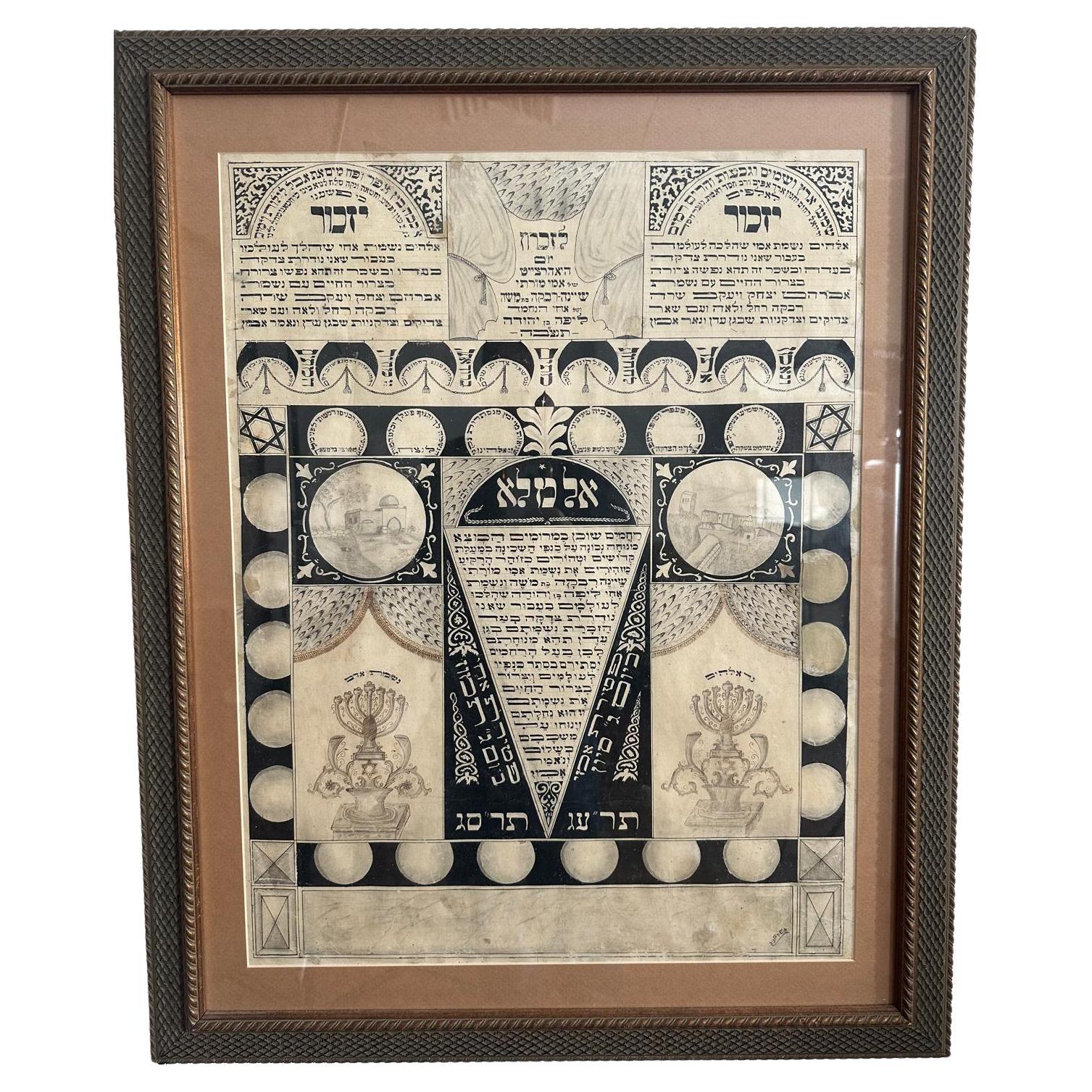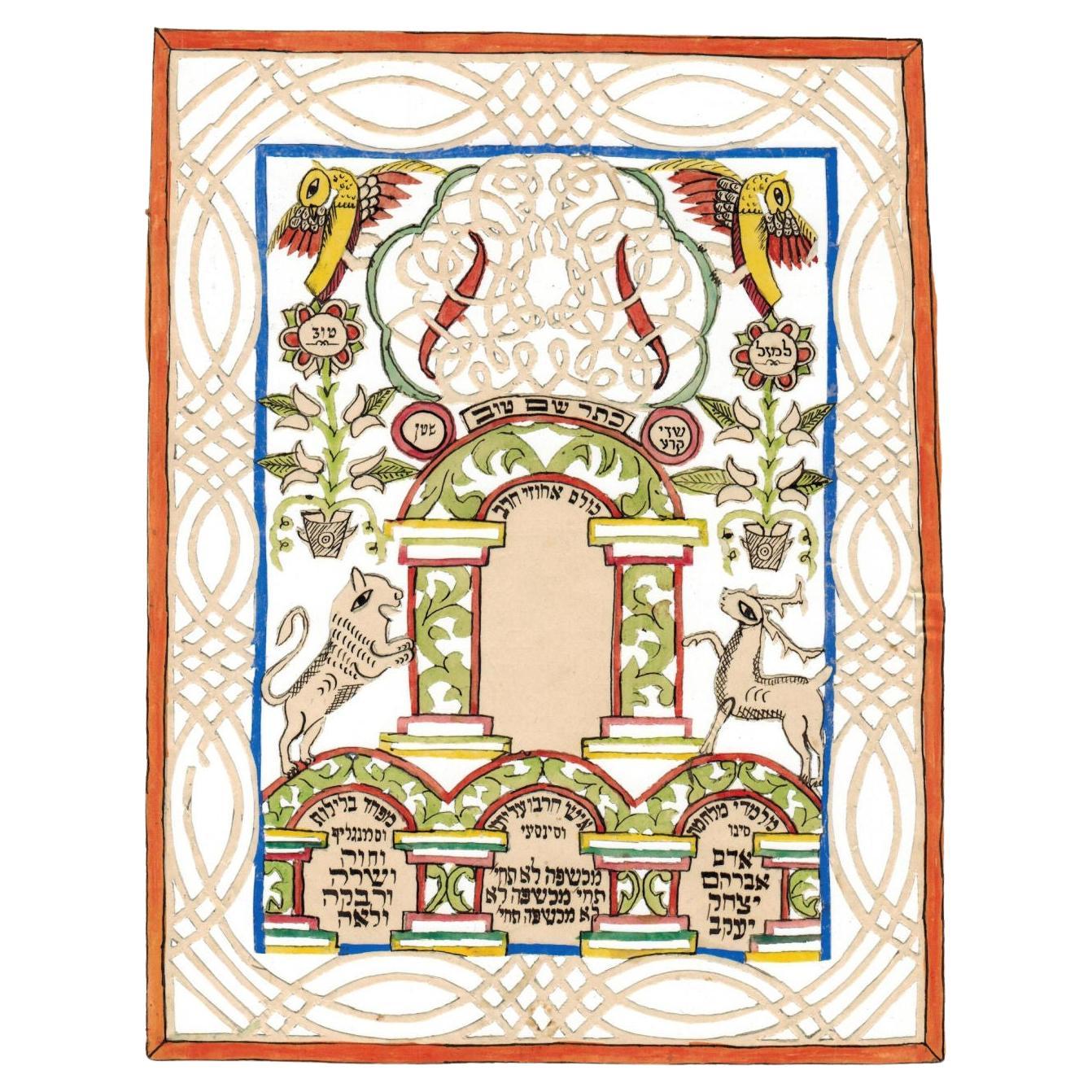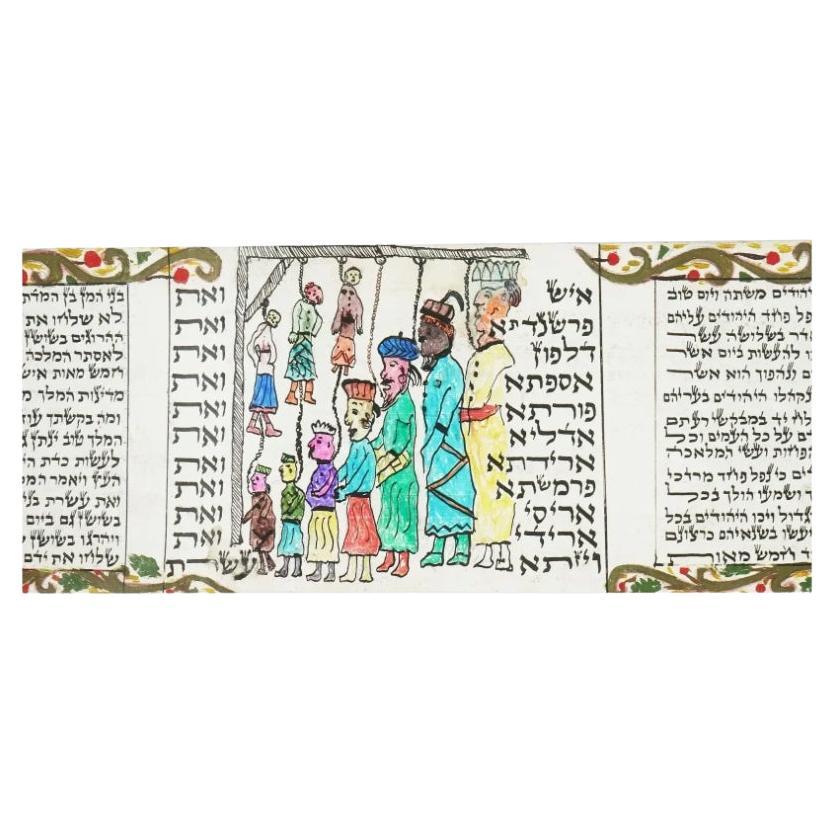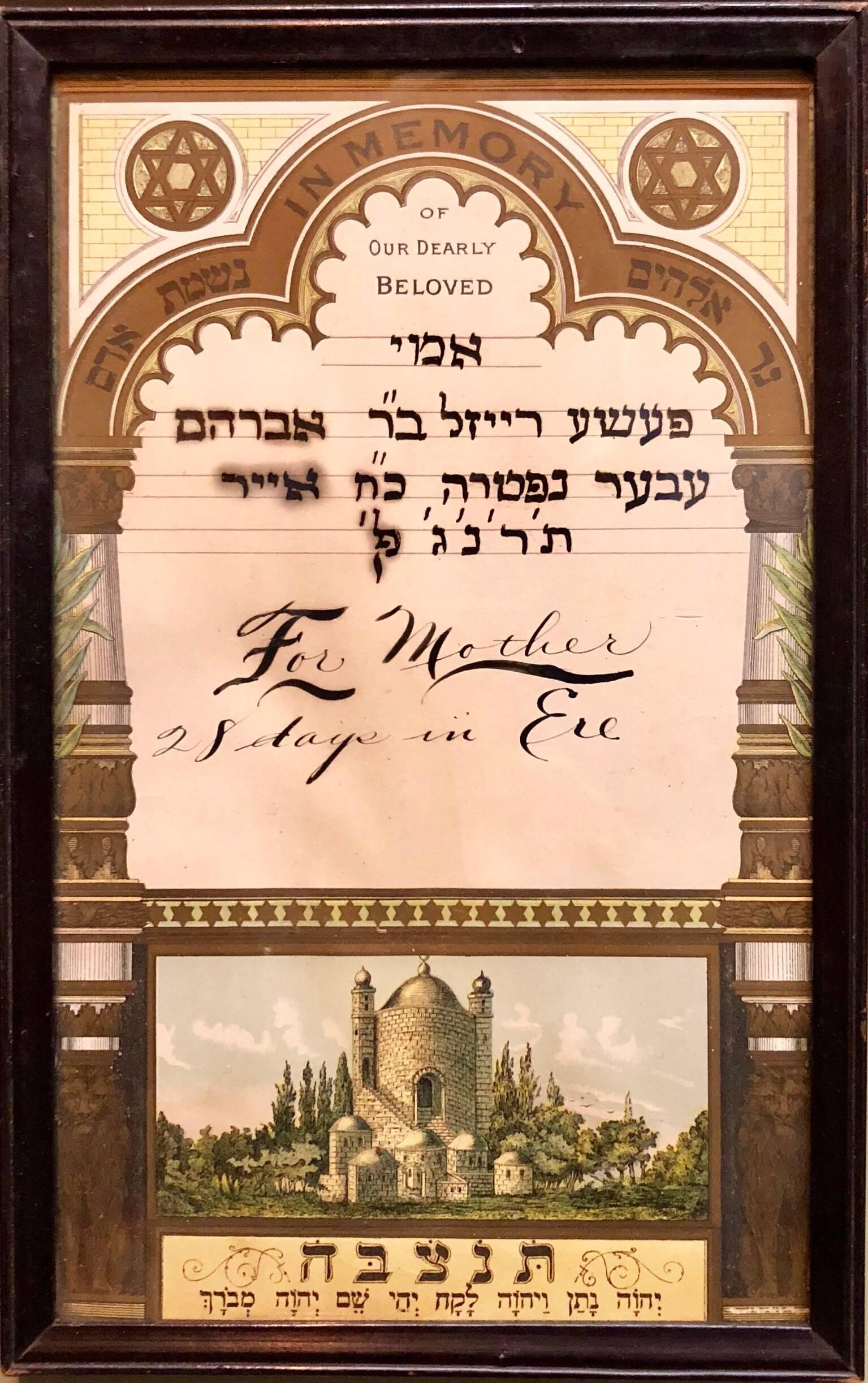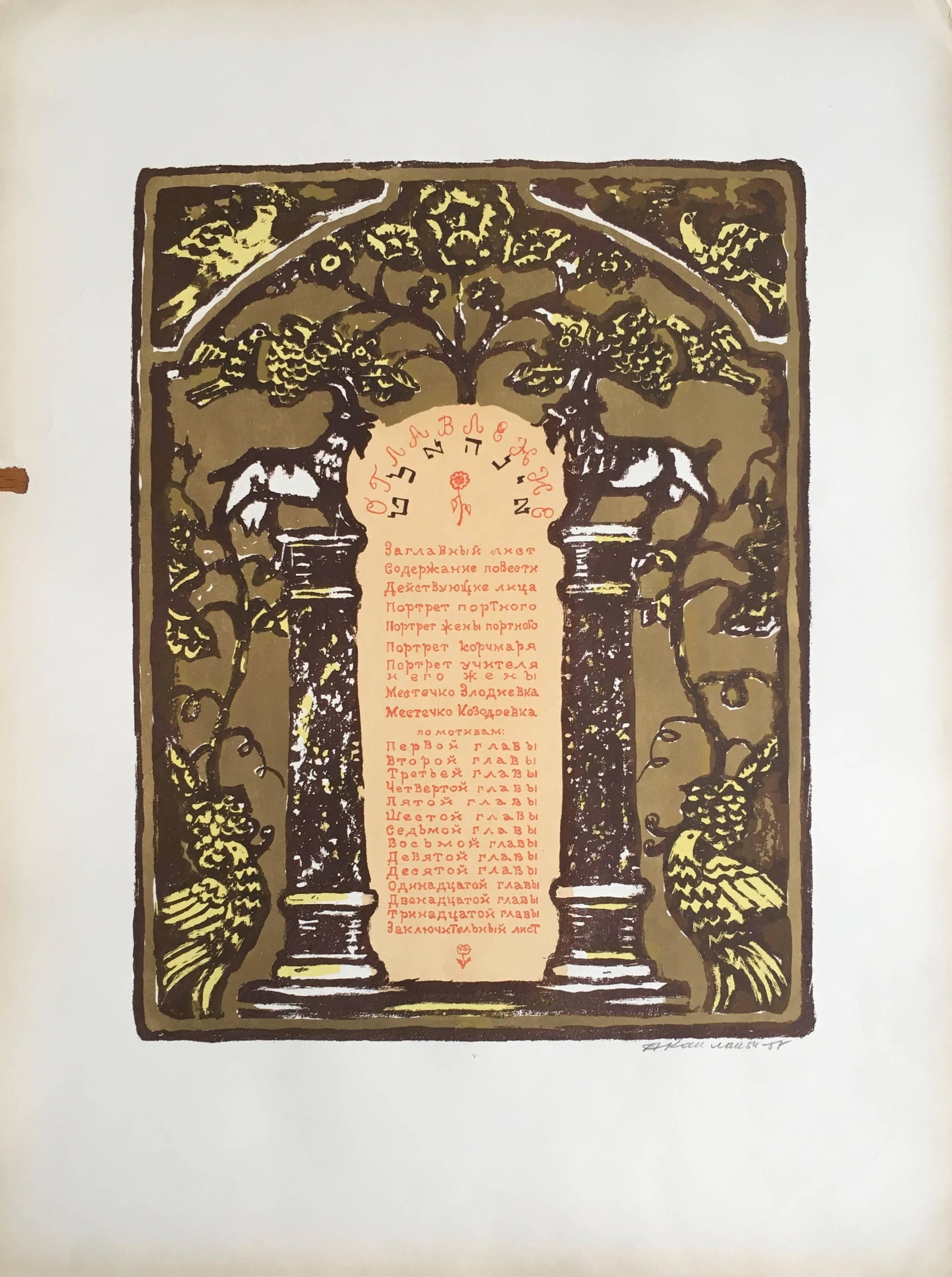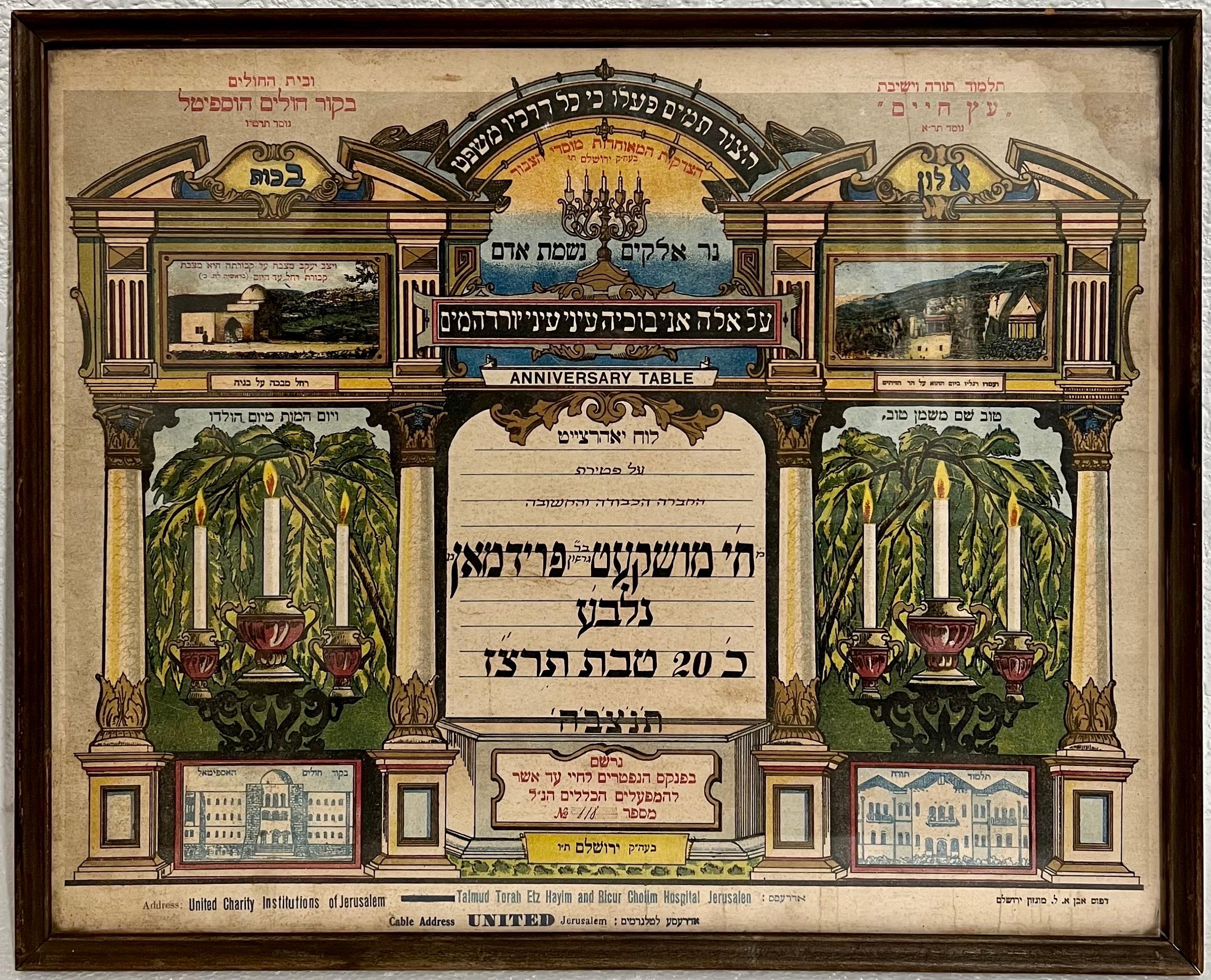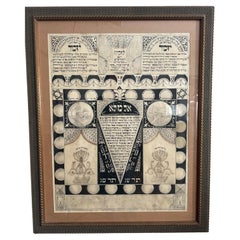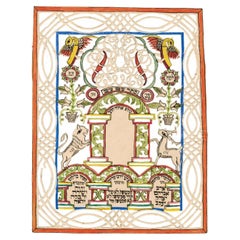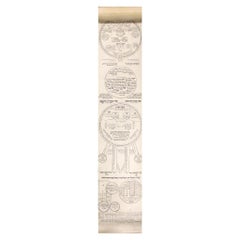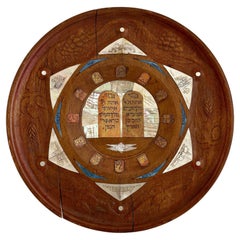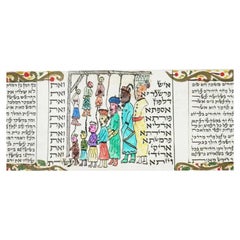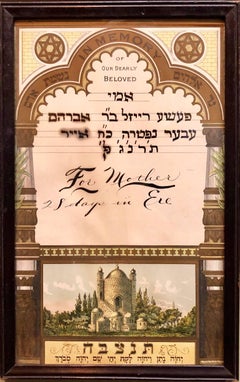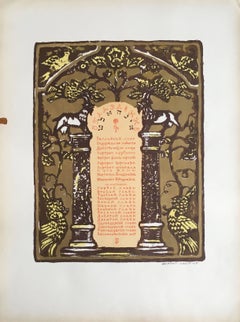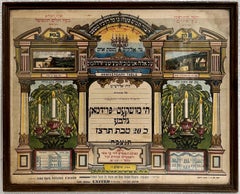Items Similar to Early 20th Century Eastern European Paper Cut Ketubah, Jewish Marriage Contract
Want more images or videos?
Request additional images or videos from the seller
1 of 5
Early 20th Century Eastern European Paper Cut Ketubah, Jewish Marriage Contract
$15,600
$19,50020% Off
£11,762.47
£14,703.0920% Off
€13,554.61
€16,943.2620% Off
CA$21,641.42
CA$27,051.7720% Off
A$24,249.09
A$30,311.3720% Off
CHF 12,622.58
CHF 15,778.2220% Off
MX$296,650.34
MX$370,812.9320% Off
NOK 160,220.24
NOK 200,275.2920% Off
SEK 151,326.10
SEK 189,157.6220% Off
DKK 101,187.91
DKK 126,484.8920% Off
Shipping
Retrieving quote...The 1stDibs Promise:
Authenticity Guarantee,
Money-Back Guarantee,
24-Hour Cancellation
About the Item
An Eastern European Kethubah Strikingly Decorated in Papercut Form, and with the Central Traditional Hebrew Text of a Most Uncommon Petite Appearance.
Uniting Yechezkel son of Shlomo with Peril daughter of Aharon. Manuscript in Hebrew composed in square script on paper. Signed by the Shochet and Cantor, Shmuel Aryeh b. Dovber and the Maggid, Hillel Ornisky. The Hebrew text at center, although prominently set, is composed within an unusually petite panel. Surrounded by elaborate papercut, featuring a Menorah below and crown above, amidst a multitude of animals and curling foliage, all painted in multiple colors. Traditional Hebrew texts above. The whole set against red cotton backing and housed within elaborate wooden frame.
‘Krol Erman’: 16th Tammuz 1907
The location in which this striking Kethubah was composed is possibly the town, where from 1925, R. Yoel Teitelbaum (later of Satmar), presided as Rabbi. It is located in northwestern Romania, near the border with Hungary and is pronounced Krula (in Yiddish), Nagykároly (in Hungarian) and Carei (in Romanian).
About the Seller
5.0
Recognized Seller
These prestigious sellers are industry leaders and represent the highest echelon for item quality and design.
Established in 2006
1stDibs seller since 2020
130 sales on 1stDibs
Typical response time: Several days
- ShippingRetrieving quote...Shipping from: New York, NY
- Return Policy
Authenticity Guarantee
In the unlikely event there’s an issue with an item’s authenticity, contact us within 1 year for a full refund. DetailsMoney-Back Guarantee
If your item is not as described, is damaged in transit, or does not arrive, contact us within 7 days for a full refund. Details24-Hour Cancellation
You have a 24-hour grace period in which to reconsider your purchase, with no questions asked.Vetted Professional Sellers
Our world-class sellers must adhere to strict standards for service and quality, maintaining the integrity of our listings.Price-Match Guarantee
If you find that a seller listed the same item for a lower price elsewhere, we’ll match it.Trusted Global Delivery
Our best-in-class carrier network provides specialized shipping options worldwide, including custom delivery.More From This Seller
View AllHungarian Yizkor and El Male Rachamim Memorial Prayer Scroll, 1903
Located in New York, NY
This finely crafted ink-on-paper manuscript from 1903 features the Yizkor and El Male Rachamim prayers, traditional Jewish memorial prayers recited for the souls of the deceased. The...
Category
Early 20th Century Hungarian Religious Items
Materials
Paper
An Important Papercut Amulet for protection of Mother and Child. Judaica
Located in New York, NY
An Important Papercut Amulet for protection of Mother and Child. Artist: David Elias Krieger, Circa, 1900
This delicate item is known as a papercut, which is a type of decorative work that was popular with Jews in Eastern Europe in the 18th and 19th centuries. The condition is quite remarkable, with no tears or repairs, but it has been folded.
This piece, entirely cut and decorated by hand, is an exquisite example of the type of Jewish papercut...
Category
Antique Early 1900s European Religious Items
Materials
Paper
Ilan ha-Kadosh, Kabbalistic Scroll on Parchment, North Africa, ca. 1900 Kabbala
Located in New York, NY
An exquisite Ilan Ha-Gadol of the type historically attributed to the great 17th-century Kabbalist Rabbi Meir Poppers.
The Ilan Ha-Gadol - the Great Ilan ('tree')– is a long parchme...
Category
Antique Early 1900s African Scholar's Objects
Materials
Parchment Paper
Early 20th Century Bezalel Jerusalem Shabbat Tray
Located in New York, NY
Early 20th century Bezalel Jerusalem wooden tray inlaid with Jerusalem stone and mother of pearl.
The large tray is carved with the Seven Species on its...
Category
Early 20th Century Israeli Folk Art Religious Items
Materials
Marble
$15,000 Sale Price
20% Off
Antique Miniature Sefer Torah Written on Parchment
Located in New York, NY
Antique Miniature Sefer Torah Written on Parchment – With Original Belt and Decorative Mantle
An extraordinary and rare example of Judaica, this antique miniature Sefer Torah is ful...
Category
Early 20th Century Religious Items
Materials
Hide, Wood
Early 20th Century Brass Plaque by Bezalel School Jerusalem
Located in New York, NY
Bezalel brass plaque depicting a Jewish elder next to the Western Wall, made in Jerusalem, circa 1920, bearing a small metal label engraved "Bezalel Jeru...
Category
Early 20th Century Israeli Decorative Art
Materials
Brass
$960 Sale Price
20% Off
You May Also Like
Antique Judaica Hand Illuminated Megillah Scroll of Esther Manuscript
Located in Long Island City, NY
An antique Megillah The Book of Esther, hand written on parchment by an expert Sephardi scribe and richly decorated with hand painted illustrations. The text panels are surrounded by...
Category
Antique 19th Century Unknown Drawings
Materials
Parchment Paper
Rare Judaica 1893 Jewish Yizkor Memorial Plaque Hebrew English Chromolithograph
Located in Surfside, FL
A rare Judaic memorial piece for mother.
Category
Late 19th Century Aesthetic Movement More Prints
Materials
Lithograph
Vintage Russian Shtetl Lithograph
By Anatoli Lvovich Kaplan
Located in Surfside, FL
Pencil signed and dated, colored Judaica Lithograph.
Anatoli Lwowitch Kaplan was a Russian painter, sculptor and printmaker, whose works often reflect his Jewish origins.
His fathe...
Category
Mid-20th Century Modern More Prints
Materials
Lithograph
Rare Palestine Antique Hebrew Judaica Yahrzeit Synagogue Sign Memorial Plaque
Located in Surfside, FL
Circa 1890-1920. This Neoclassical, Judaic, Egyptian revival, Orientalist Mizrach sign, was produced in British Mandate Palestine by the chromolithograph process at the beginning of the 20th century. It pictures vignettes of holy places. with a hand written memorial. It was for the Tzedakah charity fund for the century-old institutions in Jerusalem: The great "Torah Center Etz Chaim"; a Free Kitchen for poor children and orphans; the famous Bikur Cholim Hospital with its dispensaries and clinics and the only Home for Incurable Invalids in Eretz Israel. They also worked with Arthur Szyk and Alfred Salzmann.. The A.L. Monsohn Lithographic Press (Monzon Press, Monson Press, דפוס אבן א"ל מאנזאהן, דפוס מונזון) was established in Jerusalem in 1892 by Abraham-Leib (or Avrom-Leyb) Monsohn II (Jerusalem, c.1871-1930) and his brother Moshe-Mordechai (Meyshe-Mordkhe). Sponsored by members of the Hamburger family, the brothers had been sent to Frankfurt, Germany in 1890 to study lithography. Upon returning to Jerusalem in 1892 with a hand press, they established the A.L. Monsohn Lithographic Press in the Old City of Jerusalem. According to the Information Center for Israeli Art A.L. Monsohn "created complex decorations for documents and oriental calendars that combined the tradition of Jewish art with modern printing techniques such as photographic lithography, raised printing and gilding."
The founders of the Monsohn press produced Jewish-themed color postcards, greeting cards, Jewish National Fund stamps, and maps documenting the evolution of the Jewish settlement in Eretz Israel in the nineteenth-twentieth centuries; religious material such as decorative plaques for synagogues, portraits of Old Yishuv rabbis such as Shmuel Salant, Mizrah posters indicating the direction of prayer for synagogues, memorial posters, and posters for Sukkot booths; color frontispieces for books such as Pentateuch volumes and the early song collections of Abraham Zvi Idelsohn (e.g., Shire Zion, Jerusalem 1908); artistic wedding invitations; and labels, packaging and advertisements for the pioneering entrepreneurs of Eretz Israel. The texts appearing in the Monsohn products were in several languages: Hebrew, Arabic, Yiddish, English, German (e.g., a c1920 trilingual Hebrew-English-Arabic "Malaria Danger" broadside warning the public of mosquitoes spreading malaria). Many of the brilliantly colored postcards and maps can be seen online as can the artistic invitations to his children's weddings which Monsohn published in the Jerusalem Hebrew press.
For years, the Monsohn (later, Monson/Monzon) Press was considered the best and most innovative in the country—pioneering in such techniques as gold-embossing and offset printing, among others. Early items for tourists included collections of Flowers of the Holy Land (c. 1910–1918)—pressed local flowers accompanied by scenes from the Eretz Israel countryside and relevant verses from the Bible, edited by Jsac Chagise (or Itzhak Haggis), an immigrant from Vitebsk, and bound in carved olive wood boards. Shortly after World War I Monsohn (now spelled מונזון) used zincography to produce the prints included in the Hebrew Gannenu educational booklets for young children illustrated by Ze'ev Raban of the Bezalel Academy of Art and Design and printed in Jerusalem by Hayim Refael Hakohen (vol. 1, 1919; vols. 2–3, 1920). In 1934 Monsohn moved into the new, western part of Jerusalem, in a shop with four presses and 30 workers, including Abraham-Leib's sons, David, Yosef, Moshe and Shimon, and his daughter Raytse's husband, Abraham Barmacz. The concern did business with all sectors of the city's population, including Arabs, for whom they printed in Arabic. Among their clients were members of the Ginio, Havilio, and Elite families, and Shemen, Dubek, and other renowned national brands, manufacturing products such as wine, candies, oil, and cigarettes. They also printed movie and travel posters, and government posters, postcards and documents, hotel luggage labels...
Category
Early 20th Century Aesthetic Movement More Art
Materials
Lithograph
Antique Embroidery with Hebrew Inscriptions
Located in London, GB
Antique embroidery with Hebrew inscriptions
Continental, late 19th century
Measures: Height 91cm, width 87cm
The wall hanging is crafted from...
Category
Antique Late 19th Century European Tapestries
Materials
Textile
Vintage Russian Shtetl Judaica Lithograph
By Anatoli Lvovich Kaplan
Located in Surfside, FL
Pencil signed and dated, colored Judaica Lithograph.
Anatoli Lwowitch Kaplan was a Russian painter, sculptor and printmaker, whose works often ref...
Category
Mid-20th Century Modern More Prints
Materials
Lithograph
More Ways To Browse
Eastern European Furniture
Jewish Furniture
Crown Religious
Eastern European Painted Furniture
Jewish Menorah
Jewish Religious Items
Hungary Menorah
Mexico Religious
Christ On The Cross
Religious Icons
Carved Jesus
Catholic Religious
Mexican Colonial Furniture
Antique Religious Statues
Jesus Cross
Catholic Church Furniture
Christ Carved
Antique Church Cross
